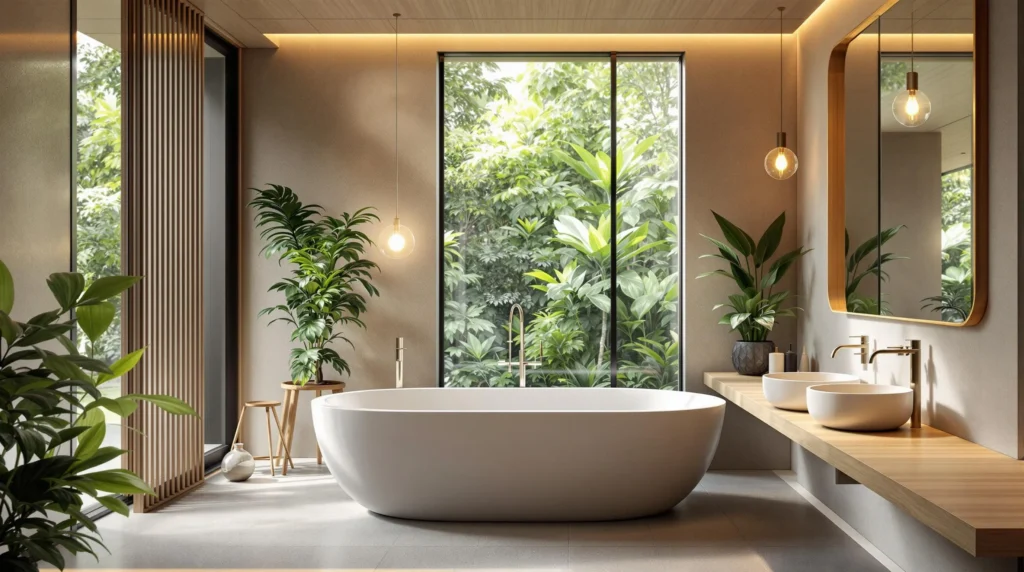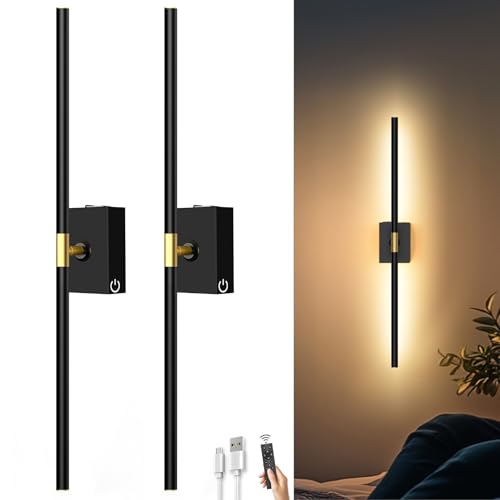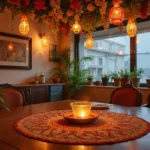Dreaming of a serene, minimalist bathroom that combines the best of Japanese tranquility and Scandinavian functionality? We’ve uncovered the essential secrets to creating a stunning Japandi style bathroom that will transform your daily routine into a spa-like experience.
At the intersection of two design powerhouses, Japandi style brings together clean lines, natural materials, and thoughtful simplicity. We’ll guide you through the perfect balance of warm and cool tones, the strategic use of natural elements, and the carefully curated minimalism that makes this aesthetic so appealing. From selecting the right fixtures to incorporating authentic touches, these insights will help you create a bathroom sanctuary that’s both beautiful and practical.
What Is Japandi Style and Why It Works in Bathrooms
Japandi style combines the best of Japanese wabi-sabi philosophy with Scandinavian hygge comfort, creating a design aesthetic that’s both functional and beautiful. This hybrid style merges Japanese minimalism and craftsmanship with Scandinavian warmth and simplicity, resulting in spaces that feel both clean and cozy simultaneously. The aesthetic emphasizes natural materials, clean lines, neutral color palettes, and thoughtful, purposeful design.
The core principles of Japandi style include:
- Minimalism – Every item serves a purpose, eliminating clutter and creating calm, open spaces
- Natural materials – Wood, stone, bamboo, and other organic elements connect the space to nature
- Neutral colors – Warm and cool neutral tones create balance and harmony
- Craftsmanship – Quality over quantity, with appreciation for handmade and artisanal items
- Balance – Finding harmony between contrasting elements like light and dark, soft and hard
Bathrooms provide the perfect canvas for Japandi design because they naturally benefit from the style’s emphasis on cleanliness, organization, and tranquility. The inherent functionality of Scandinavian design addresses the practical needs of a bathroom, while Japanese aesthetic principles transform the space into a sanctuary for relaxation and rejuvenation.
We’ve found that Japandi bathrooms excel at meeting both practical and emotional needs. The style’s focus on natural materials creates warmth in a typically cold space. Its emphasis on quality craftsmanship ensures durability in a high-moisture environment. The commitment to simplicity means easier cleaning and maintenance, while the balanced aesthetic promotes genuine relaxation during daily routines.
Unlike purely minimalist styles that can feel stark or clinical, Japandi bathrooms maintain warmth through natural textures and thoughtful design. This approach creates spaces that feel intentionally curated rather than empty, making even small bathrooms feel spacious yet intimate.
The Art of Simplicity: Minimalist Fixtures and Essentials

Japandi bathrooms excel at merging Japanese minimalism with Scandinavian functionality, creating spaces that feel both tranquil and purposeful. The foundation of this aesthetic relies on clean lines, uncluttered surfaces, and thoughtfully selected fixtures that serve both form and function.
Strategic Placement of Elements
Strategic design in Japandi bathrooms focuses on creating harmonious flow through purposeful layouts. Built-in storage answers like recessed niches and concealed cabinetry keep everyday items hidden from view, maintaining the clean aesthetic essential to this style. Open pathways throughout the bathroom ensure seamless movement, honoring Zen principles of unobstructed energy flow. We recommend creating focal points—such as a freestanding soaking tub or textured accent wall—that anchor the space without overwhelming it. Natural light plays a crucial role in Japandi bathrooms; maximize brightness through large windows or install semi-opaque screens that maintain privacy while allowing light to filter through. This thoughtful arrangement of elements creates a sense of spaciousness and tranquility that defines the Japandi bathroom experience.
Quality Over Quantity Approach
The essence of Japandi design lies in its commitment to quality materials that stand the test of time. Invest in durable woods like teak or oak for vanities, as they naturally resist bathroom humidity while adding organic warmth. Handcrafted ceramics for sinks or bath accessories introduce artisanal character, while washi paper lighting fixtures provide gentle illumination with textural interest. We advocate limiting decorative elements to just one or two statement pieces—perhaps a live-edge wooden shelf or a minimalist plant arrangement—ensuring each item serves either an aesthetic or functional purpose. Wall-mounted vanities create visual space while streamlined fixtures like frameless mirrors maintain the clean aesthetic. Natural textures found in bamboo bath stools, stone basins, and wooden accents add dimension without creating visual clutter. This deliberate approach to selection creates a bathroom that feels both sophisticated and serene, striking the perfect balance between tranquility and practicality.
Natural Materials: The Foundation of Japandi Bathroom Design

Natural materials form the essential cornerstone of any authentic Japandi bathroom design. This aesthetic marries Japanese minimalism with Scandinavian functionality, prioritizing organic elements that create a serene, spa-like atmosphere.
Incorporating Wood and Stone Elements
Wood brings irreplaceable warmth and character to Japandi bathrooms, creating a perfect balance against cooler elements. Oak, maple, and walnut are excellent choices for vanities, floating shelves, or even statement bathtubs that serve as focal points. These wooden features infuse the space with organic texture while maintaining clean lines essential to the Japandi aesthetic.
Stone elements introduce a raw, tactile quality that grounds the bathroom design in nature. Granite, marble, and slate work beautifully as countertops or basin materials, offering durability alongside visual interest. The natural veining and subtle color variations in stone provide depth without overwhelming the space, keeping with Japandi’s minimalist principles.
For maximum impact, we recommend combining both materials—perhaps a wooden vanity topped with a stone basin or stone floor tiles complemented by wooden wall accents. This thoughtful integration celebrates the beauty of natural materials while maintaining the functional simplicity that defines Japandi style.
Sustainable Material Choices
Bamboo stands out as an exceptionally sustainable option that aligns perfectly with Japandi values. This fast-growing material brings a light, airy quality to bathroom accessories such as storage baskets, bath mats, or even smaller furniture pieces. Its natural resilience to moisture makes bamboo particularly suitable for bathroom environments.
Reclaimed wood offers another eco-conscious choice that adds character through its unique patina and history. Salvaged timber can be repurposed into stunning countertops, shelving, or decorative elements that tell a story while reducing environmental impact. The weathered quality of reclaimed wood often provides visual interest without requiring additional finishes or treatments.
Each sustainable material choice should serve both form and function, maintaining the clutter-free environment central to Japandi design. Storage answers crafted from these materials help conceal everyday items while contributing to the overall aesthetic harmony of the space.
The Perfect Japandi Color Palette for Bathroom Serenity
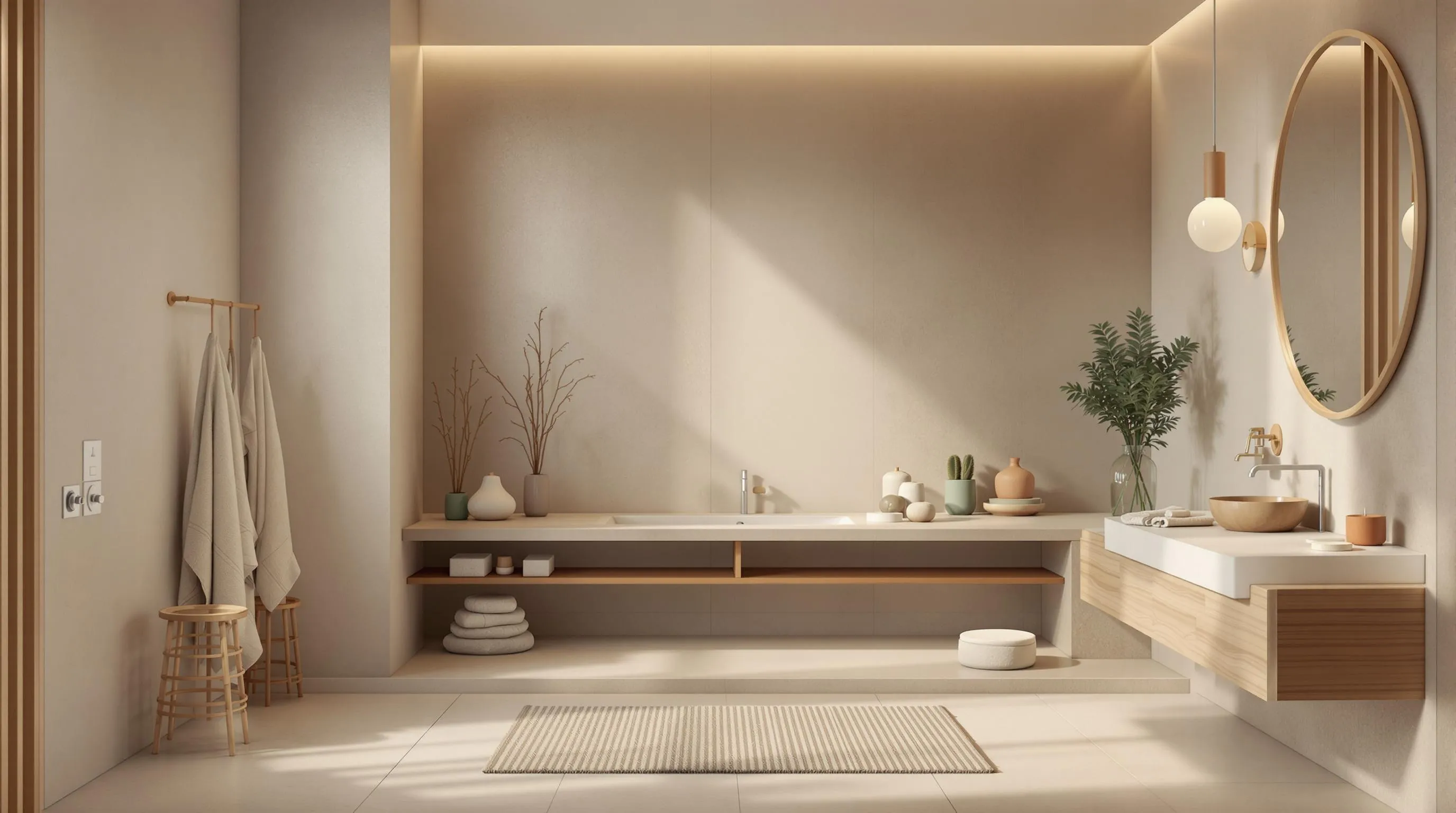
The right color scheme forms the foundation of any successful Japandi bathroom design. Creating a harmonious palette that balances Japanese tranquility with Scandinavian warmth requires thoughtful selection of both base and accent colors.
Neutral Base Colors
Japandi bathrooms thrive on a foundation of muted neutrals that create a sense of calm and spaciousness. Whites, beiges, light grays, and soft browns serve as the perfect canvas for this minimalist aesthetic. These understated tones allow natural materials like wood and stone to take center stage, improving their organic beauty rather than competing with it. The neutral palette reflects both Japanese simplicity and Scandinavian brightness, making spaces feel larger and more serene. We recommend using these soft hues on larger surfaces such as walls, floors, and major fixtures to establish the peaceful atmosphere that defines Japandi style.
Strategic Accent Tones
Accent colors in Japandi bathrooms should complement rather than dominate the neutral base. Earthy terracotta, soft sage green, or sophisticated charcoal gray can add subtle depth and visual interest without disrupting the overall tranquility. These strategic touches of color create warmth and dimension while maintaining the “less-is-more” philosophy central to Japandi design. Apply accent tones thoughtfully through textiles, ceramics, or small accessories rather than bold statement walls. The restrained use of these complementary colors helps achieve the perfect balance between the cooler Scandinavian elements and warmer Japanese influences, resulting in a bathroom that feels both cohesive and intentionally designed.
Balancing Warmth and Functionality in Lighting Choices

Creating the perfect Japandi bathroom experience requires thoughtful consideration of lighting elements that blend functionality with a sense of tranquility. In Japandi design, lighting serves as both a practical necessity and a mood-setting feature that enhances the overall aesthetic.
Layered Lighting Techniques
The secret to successful Japandi bathroom lighting lies in thoughtfully combining different light sources to create depth and versatility. We recommend incorporating a strategic combination of overhead lighting, task lighting, and ambient options to establish a functional yet serene atmosphere. This layered approach ensures your bathroom remains practical for everyday tasks while maintaining the calm ambiance essential to Japandi style. Wall sconces positioned at eye level can provide balanced illumination while minimizing harsh shadows. Recessed ceiling fixtures deliver clean, unobtrusive general lighting that complements the minimalist aesthetic. Adding dimmable features to your lighting system allows you to adjust brightness levels according to different needs and times of day, perfectly aligning with the Japandi principle of adaptable functionality.
Natural Light Maximization
Natural light forms a cornerstone element in authentic Japandi bathroom design, creating an essential connection to the outdoors while reducing reliance on artificial lighting. Large windows, skylights, or light tubes can dramatically transform your bathroom by flooding it with daylight and improving the sense of openness central to Japandi spaces. Privacy concerns can be addressed through frosted glass, lightweight bamboo blinds, or sheer curtains that filter light while maintaining seclusion. Strategically placed mirrors opposite windows amplify natural light, making the space feel larger and more open. The interaction between natural light and natural materials like wood and stone creates ever-changing visual interest throughout the day as shadows and highlights shift, adding subtle movement and character to your Japandi bathroom without disrupting its peaceful quality.
The Bamboo Effect: Adding Greenery to Your Japandi Bathroom
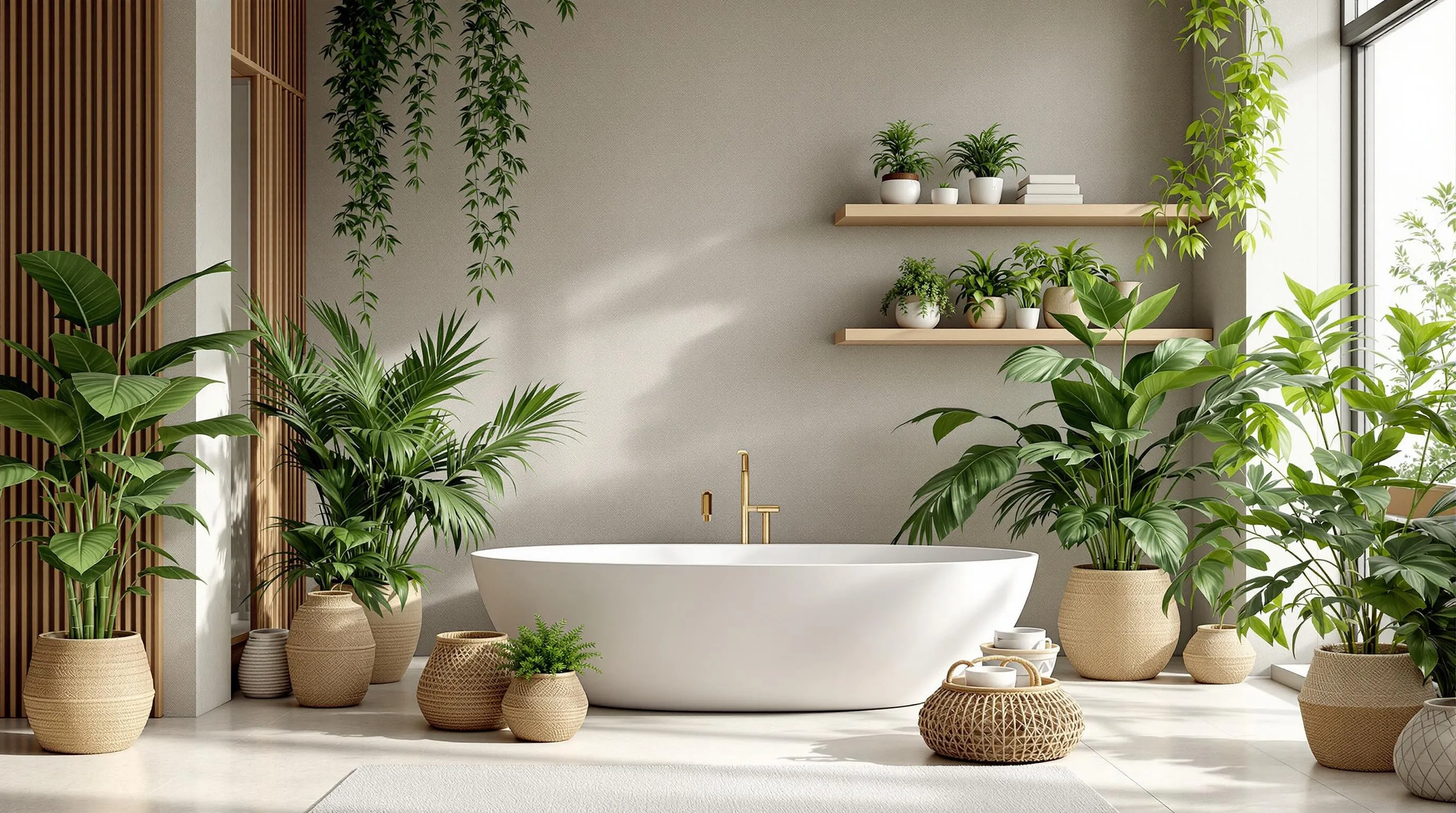
Plants are the perfect finishing touch for any Japandi bathroom, introducing life and organic elements that complement the natural materials already present in your design.
Low-Maintenance Plant Selection
When selecting plants for your Japandi bathroom, focus on air-purifying species that thrive in humid environments. Snake plants stand out as an excellent choice, requiring minimal care while adding vertical interest and natural texture to your space. Bamboo palms work wonderfully in bathrooms with their humidity-loving nature and architectural silhouette that perfectly embodies the Japandi aesthetic. These resilient plants not only enhance air quality but also maintain their beauty with little attention, aligning perfectly with the Japandi philosophy of simplicity and functionality. Peace lilies and aloe vera also flourish in bathroom environments, adding unique shapes and subtle greenery without demanding excessive maintenance.
Strategic Placement for Visual Impact
Position your plants thoughtfully to create maximum visual impact while maintaining the clean lines essential to Japandi design. Near bathtubs, plants create a spa-like atmosphere, softening the rigid lines of fixtures and introducing a natural focal point. Floating shelves offer perfect platforms for smaller plants, allowing them to cascade gently without cluttering valuable counter space. Handcrafted ceramic pots and woven baskets make ideal vessels for your greenery, reinforcing the emphasis on craftsmanship central to Japandi style. Plants strategically placed near mirrors will reflect throughout the space, multiplying their visual impact without adding physical clutter. The organic shapes of foliage provide a beautiful contrast to the geometric elements typically found in bathroom design, creating balance and harmony that’s essential to the Japandi aesthetic.
Storage Solutions That Maintain Clean Lines and Harmony

In Japandi bathroom design, storage answers play a crucial role in preserving the clean aesthetic while ensuring functionality. Effective storage maintains the minimalist harmony that defines this style, keeping essentials accessible yet visually unobtrusive.
Hidden Storage Ideas
Built-in storage cabinets offer the perfect solution for maintaining clutter-free surfaces in your Japandi bathroom. These thoughtfully designed elements blend seamlessly with walls or vanities, preserving the room’s clean lines while providing ample space for toiletries and essentials. Under-sink storage transforms often unused space into valuable organization areas, with drawers or shelves that keep cleaning supplies and extra items neatly tucked away.
Sliding panels present another elegant storage option that aligns perfectly with Japanese design sensibilities. These movable elements conceal contents while adding an architectural detail that enhances the room’s aesthetic appeal. Magnetic strips hidden behind floating shelves can discreetly store metal items like tweezers or nail clippers, maintaining the bathroom’s serene appearance without sacrificing practicality.
Open Shelving Done Right
Minimalist display techniques form the foundation of successful open shelving in Japandi bathrooms. Limiting decorative items to just a few carefully selected pieces—perhaps a small plant, handcrafted soap dish, or single artwork—preserves the calm atmosphere essential to this design style. Functional display strategies encourage keeping only frequently used items like premium soap dispensers or neatly folded hand towels on open shelves, combining beauty with everyday utility.
Textural balance creates visual interest when incorporating open shelving units. Wood shelving against stone walls or concrete shelves paired with warm wooden accents adds depth and dimension without cluttering the space. Strategic placement of these open elements should complement rather than compete with other bathroom features, maintaining the harmonious flow that characterizes Japandi design.
Creating Spa-Like Experiences Through Thoughtful Accessories
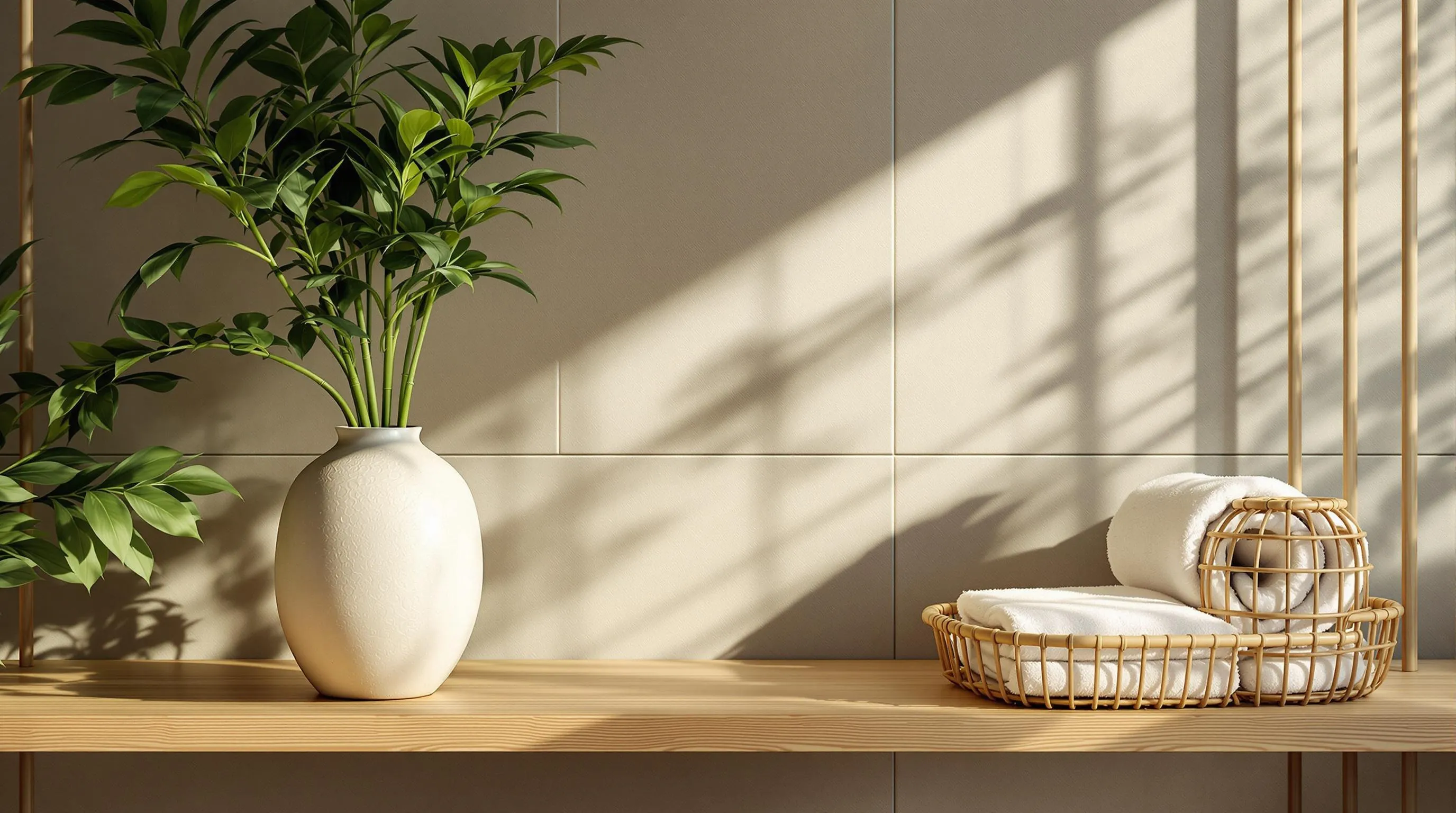
Transforming your Japandi bathroom into a true sanctuary requires thoughtful selection of accessories that enhance both function and ambiance. The right elements can elevate your space from simply stylish to genuinely restorative.
Plants
Plants serve as vital components in any Japandi bathroom, breathing life into the space while reinforcing the connection to nature. Select varieties that thrive in humid environments like ferns, peace lilies, or bamboo to add lush texture without demanding excessive maintenance. Position your greenery strategically—perhaps a tall plant in an empty corner or small potted specimens on wooden shelves—to create visual interest without disrupting the clean lines of your design. The natural elements these plants introduce perfectly complement wooden features while softening the overall aesthetic of your bathroom retreat.
Handcrafted Decor Elements
Handcrafted items bring authentic character and soul to your Japandi bathroom through their uniqueness and artisanal quality. Ceramic vessels, handmade soap dishes, and woven baskets showcase the craftsmanship that sits at the heart of both Japanese and Scandinavian design traditions. These pieces tell stories through their imperfections, embodying the wabi-sabi philosophy that celebrates beauty in imperfection. We recommend selecting just a few statement handcrafted elements rather than filling every surface—perhaps a sculptural ceramic vase or handwoven towels—to maintain the minimalist approach while adding layers of visual and tactile interest to your space.
Functional Luxury Items
Functional luxury in a Japandi bathroom combines practicality with exceptional materials and craftsmanship. Wooden bathtubs serve as stunning centerpieces that offer both visual warmth and sensory pleasure, creating an immediate spa-like atmosphere. Stone sinks provide tactile contrast and lasting durability while exuding natural elegance. Bamboo accessories—from bath caddies to towels—introduce sustainable luxury through their renewable nature and pleasingly soft texture. These elements marry form with function perfectly, offering everyday utility wrapped in natural beauty. When selecting these items, focus on quality materials that will patina beautifully over time, reinforcing the Japandi commitment to longevity and thoughtful consumption.
Japandi Bathroom Layouts: Making the Most of Your Space
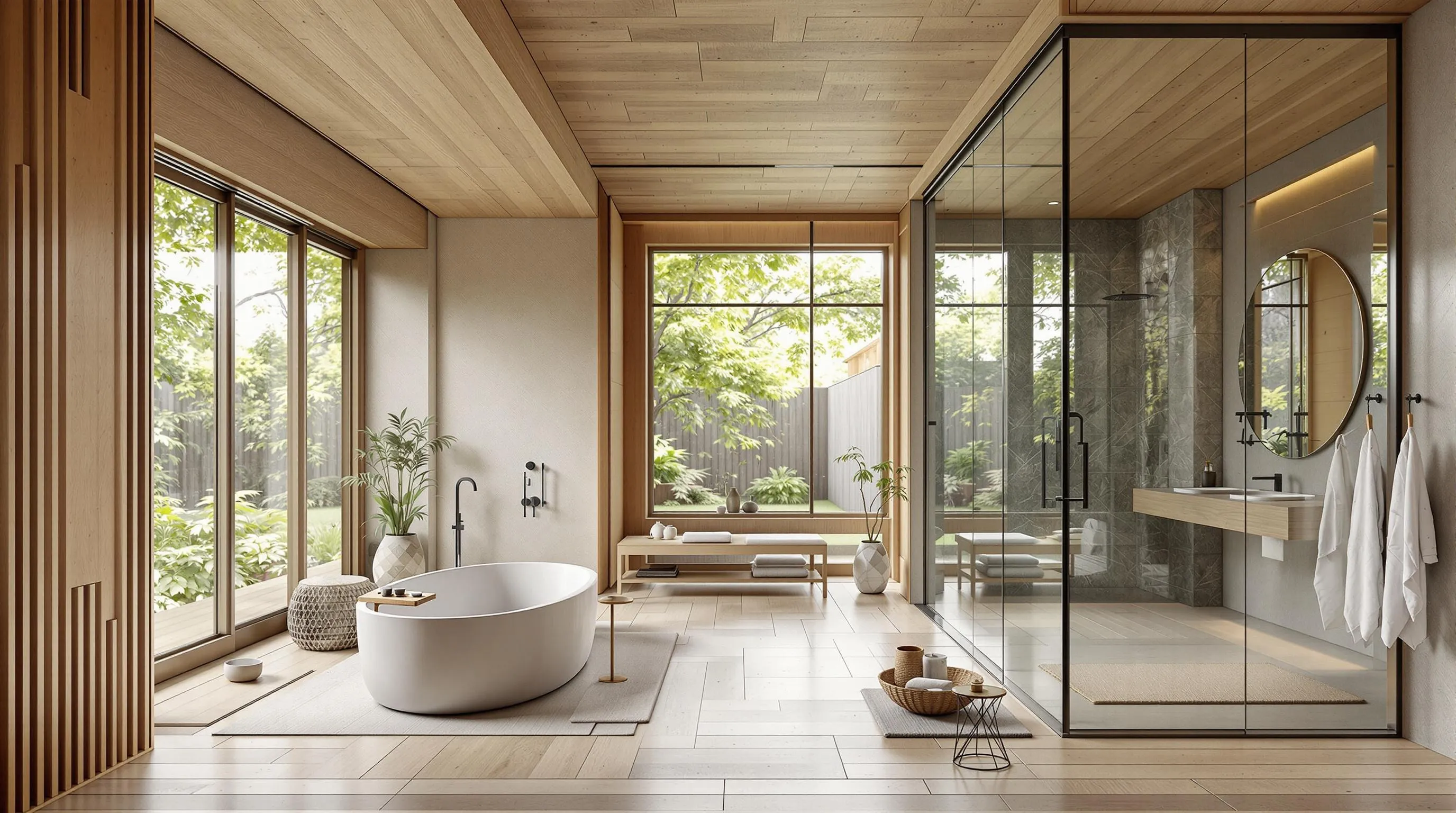
The layout of your bathroom can make or break your Japandi design vision. Whether working with a compact space or a generous bathroom, thoughtful planning ensures both functionality and aesthetic harmony.
Small Bathroom Japandi Answers
Small bathrooms thrive with Japandi styling thanks to the style’s inherent minimalism and focus on functionality. We recommend embracing a decluttered approach with built-in storage answers to maintain clean lines and visual openness. Wall-mounted fixtures serve dual purposes—they create an illusion of more floor space while adhering to the minimalist aesthetic that defines Japandi style. Carefully plan the natural flow of your bathroom by designing clear pathways around fixtures, allowing for comfortable movement in limited spaces. Lighting plays a crucial role in small Japandi bathrooms; maximize natural light through large windows or strategically placed skylights to create an airy, expansive feel. This approach not only brightens the space but also strengthens the connection to nature that’s fundamental to authentic Japandi design.
Larger Bathroom Zoning Techniques
Larger bathrooms offer exciting opportunities to create distinct functional zones while maintaining cohesive Japandi styling. Consider implementing an open-plan wet room design with sleek glass partitions to establish modern functionality without sacrificing the clean aesthetic. Divide your spacious bathroom into purposeful areas—dedicated zones for showering, bathing, and dressing—using natural materials and subtle textural changes rather than harsh visual barriers. Textural contrast serves as both a practical and visual zoning technique; combine smooth stone surfaces with rough wooden elements to create interest while defining different areas. Materials like wooden bathtubs or natural pebble flooring add warmth and organic elements that elevate larger bathrooms from merely spacious to thoughtfully designed sanctuaries. Japanese-inspired art pieces or nature-inspired decor can further enhance the tranquil ambiance of your zoned bathroom spaces, creating focal points that guide the eye naturally through the room.
Maintaining Your Japandi Bathroom: Practical Care Tips
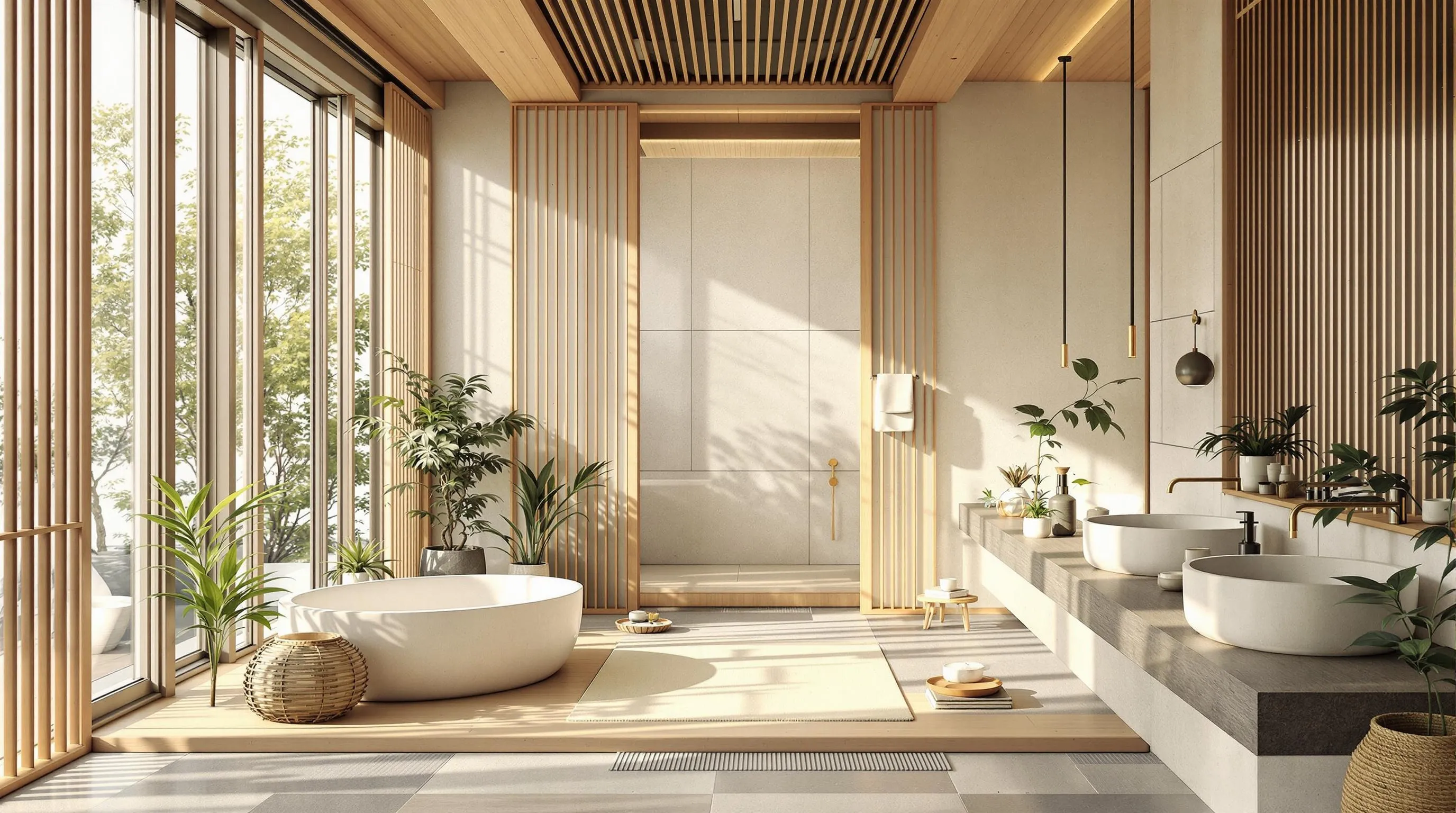
Creating a stunning Japandi bathroom is just the beginning—maintaining its serene beauty requires consistent care and attention. We’ve compiled essential maintenance tips to help preserve the natural elements and minimalist aesthetic that make your Japandi bathroom so special.
Daily Maintenance Routines
Regular dusting of natural materials prevents buildup and maintains their authentic appearance. Wood elements in particular benefit from daily attention, as dust can dull their warm tones and diminish the calming atmosphere you’ve worked to create. A soft microfiber cloth works perfectly for this purpose without scratching delicate surfaces.
Gentle Cleaning Answers
Natural materials demand gentle treatment to preserve their integrity and appearance. We recommend avoiding harsh chemical cleaners that can damage wood, bamboo, and stone surfaces. Instead, opt for mild, eco-friendly cleaning products that complement the sustainable ethos of Japandi design. For wooden elements, a mixture of mild soap and water works wonderfully when applied with a soft cloth and quickly dried afterward.
Humidity Management
Proper ventilation serves as the foundation of bathroom maintenance, especially in Japandi designs where natural materials feature prominently. Ensure your bathroom has adequate airflow by using exhaust fans during and after showers. Opening windows when possible also helps reduce moisture levels that could potentially damage wooden fixtures or create mold issues in your tranquil space.
Wood Element Preservation
Wooden and bamboo elements require special attention in the moisture-rich bathroom environment. We suggest applying a natural oil or sealant specifically designed for bathroom use every few months to protect these materials from water damage. This treatment not only preserves the wood but also enhances its natural grain and warmth, reinforcing the earthy tones that define your Japandi color palette.
Stone Surface Care
Stone surfaces like countertops and floor tiles benefit from periodic resealing to maintain their water resistance and natural beauty. Check manufacturer recommendations for your exact stone type, as different materials have unique care requirements. Generally, resealing once or twice yearly keeps these surfaces looking pristine while protecting them from stains and water damage.
Plant Maintenance
The plants that bring life to your Japandi bathroom need regular attention too. Remove any dead leaves promptly to maintain their aesthetic appeal and health. Monitor soil moisture levels in your bathroom plants, adjusting watering schedules according to humidity levels rather than following a strict calendar approach.
Minimalist Clutter Control
Maintaining the uncluttered aesthetic essential to Japandi style requires ongoing discipline. We suggest implementing a “one in, one out” policy for bathroom items to prevent accumulation of unnecessary products. Regular assessment of your bathroom contents helps preserve the minimalist environment that makes your space feel calm and spacious.
Seasonal Deep Cleaning
Beyond daily care, schedule quarterly deep cleaning sessions to address areas that might be overlooked in regular maintenance. This includes checking grout lines, cleaning light fixtures, and inspecting wooden elements for any signs of water damage. These thorough inspections help prevent small issues from developing into costly problems while keeping your Japandi bathroom looking immaculate.
Bringing It All Together: Japandi Bathroom Design Principles
Creating your dream Japandi bathroom isn’t just about following trends—it’s about crafting a sanctuary that serves your wellbeing. By embracing minimalism natural materials balanced lighting and thoughtful storage we’ve shown how this design philosophy creates spaces that are both functional and deeply calming.
Remember that true Japandi style celebrates imperfection alongside intention. Each element from your wooden vanity to your carefully selected plants should contribute to the overall harmony while serving a purpose.
We hope these secrets inspire you to transform your bathroom into a space where Japanese tranquility meets Scandinavian functionality. With these principles as your guide you’ll create not just a stunning bathroom but a personal retreat that nurtures both body and spirit for years to come.
Frequently Asked Questions
What is Japandi style in bathroom design?
Japandi style combines Japanese minimalism with Scandinavian functionality to create serene bathrooms. It features clean lines, natural materials like wood and stone, and a neutral color palette. This design philosophy embraces the Japanese wabi-sabi concept of finding beauty in imperfection while incorporating Scandinavian hygge comfort, resulting in spaces that are both practical and aesthetically pleasing.
What colors work best for a Japandi bathroom?
Muted neutrals form the foundation of Japandi bathrooms—whites, beiges, light grays, and soft browns create a calm atmosphere. Accent colors like earthy terracotta, soft sage green, and sophisticated charcoal gray add depth without disrupting tranquility. Apply colors thoughtfully through textiles and small accessories, maintaining the minimalist “less-is-more” approach central to Japandi design.
How important is lighting in a Japandi bathroom?
Lighting is crucial in Japandi bathrooms, requiring a balance between functionality and tranquility. Implement layered lighting with overhead, task, and ambient options to create serenity while ensuring practicality. Maximize natural light through windows, skylights, and strategically placed mirrors. The interaction between light and natural materials adds visual interest while maintaining the peaceful quality essential to Japandi design.
What storage solutions work for Japandi bathrooms?
Effective storage maintains Japandi’s minimalist aesthetic while ensuring functionality. Opt for built-in cabinets, under-sink solutions, and sliding panels to keep surfaces clutter-free. When using open shelving, display only carefully selected items. Combine wood and stone elements for textural balance. The goal is concealing everyday items while maintaining clean lines and harmonious flow throughout the space.
Which plants are best for Japandi bathrooms?
Choose low-maintenance, humidity-loving plants like snake plants, bamboo palms, and peace lilies that thrive in bathroom environments. These plants enhance the connection to nature while requiring minimal care. Place them strategically to maximize visual impact without disrupting clean lines. Use handcrafted pots that complement the natural materials in your bathroom for a cohesive look.
How do I maintain wooden elements in a bathroom?
Protect wooden elements through proper humidity management with adequate ventilation and dehumidifiers when necessary. Clean wood surfaces with mild, non-abrasive products specifically designed for wood care. Apply protective oils or sealants according to manufacturer recommendations to prevent water damage. Wipe up standing water immediately and perform regular maintenance to preserve the natural beauty and extend the lifespan of wooden features.
What makes Japandi different from pure Japanese or Scandinavian style?
Japandi merges Japanese wabi-sabi (finding beauty in imperfection) with Scandinavian functionality and hygge comfort. While pure Japanese design might emphasize tradition and minimalism more strictly, and Scandinavian design often incorporates brighter whites and more playful elements, Japandi balances both with earthy neutrals, natural materials, and craftsmanship. The result is more warm and lived-in than Japanese minimalism alone, yet more serene than typical Scandinavian spaces.
Can I achieve a Japandi bathroom in a small space?
Absolutely! Japandi principles actually benefit small bathrooms through their emphasis on minimalism and functionality. Focus on built-in storage to reduce clutter, use light neutral colors to create spaciousness, and incorporate mirrors to enhance natural light. Choose multi-functional fixtures and limit decorative items to essentials. The Japandi philosophy of “less is more” makes even compact bathrooms feel spacious yet intimate and serene.

